child restraint BMW M3 COUPE 2008 E92 Owner's Manual
[x] Cancel search | Manufacturer: BMW, Model Year: 2008, Model line: M3 COUPE, Model: BMW M3 COUPE 2008 E92Pages: 172, PDF Size: 5.29 MB
Page 37 of 172
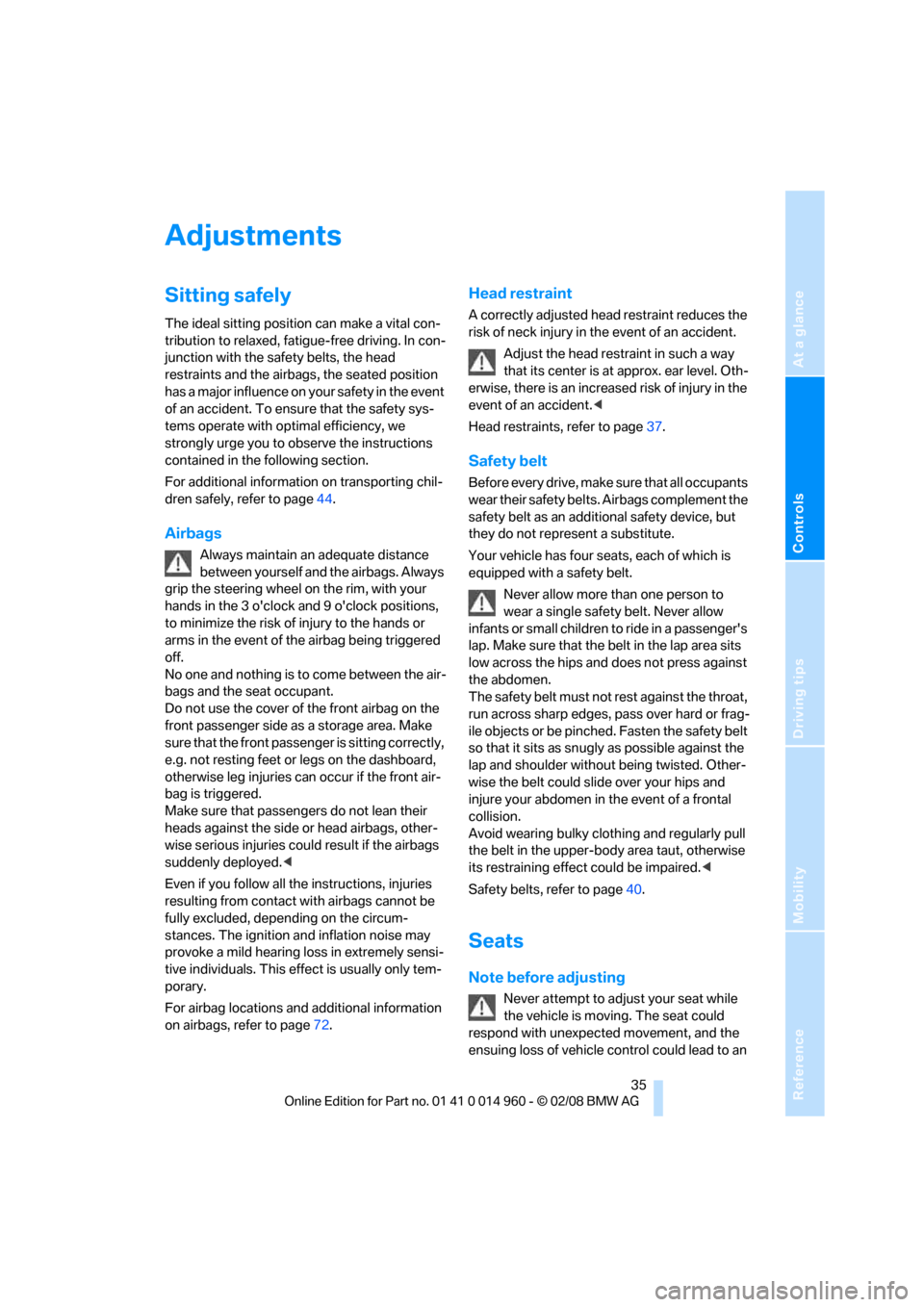
Reference
At a glance
Controls
Driving tips
Mobility
35
Adjustments
Sitting safely
The ideal sitting position can make a vital con-
tribution to relaxed, fatigue-free driving. In con-
junction with the safety belts, the head
restraints and the airbags, the seated position
has a major influence on your safety in the event
of an accident. To ensure that the safety sys-
tems operate with optimal efficiency, we
strongly urge you to observe the instructions
contained in the following section.
For additional information on transporting chil-
dren safely, refer to page44.
Airbags
Always maintain an adequate distance
between yourself and the airbags. Always
grip the steering wheel on the rim, with your
hands in the 3 o'clock and 9 o'clock positions,
to minimize the risk of injury to the hands or
arms in the event of the airbag being triggered
off.
No one and nothing is to come between the air-
bags and the seat occupant.
Do not use the cover of the front airbag on the
front passenger side as a storage area. Make
sure that the front passenger is sitting correctly,
e.g. not resting feet or legs on the dashboard,
otherwise leg injuries can occur if the front air-
bag is triggered.
Make sure that passengers do not lean their
heads against the side or head airbags, other-
wise serious injuries could result if the airbags
suddenly deployed.<
Even if you follow all the instructions, injuries
resulting from contact with airbags cannot be
fully excluded, depending on the circum-
stances. The ignition and inflation noise may
provoke a mild hearing loss in extremely sensi-
tive individuals. This effect is usually only tem-
porary.
For airbag locations and additional information
on airbags, refer to page72.
Head restraint
A correctly adjusted head restraint reduces the
risk of neck injury in the event of an accident.
Adjust the head restraint in such a way
that its center is at approx. ear level. Oth-
erwise, there is an increased risk of injury in the
event of an accident.<
Head restraints, refer to page37.
Safety belt
Before every drive, make sure that all occupants
wear their safety belts. Airbags complement the
safety belt as an additional safety device, but
they do not represent a substitute.
Your vehicle has four seats, each of which is
equipped with a safety belt.
Never allow more than one person to
wear a single safety belt. Never allow
infants or small children to ride in a passenger's
lap. Make sure that the belt in the lap area sits
low across the hips and does not press against
the abdomen.
The safety belt must not rest against the throat,
run across sharp edges, pass over hard or frag-
ile objects or be pinched. Fasten the safety belt
so that it sits as snugly as possible against the
lap and shoulder without being twisted. Other-
wise the belt could slide over your hips and
injure your abdomen in the event of a frontal
collision.
Avoid wearing bulky clothing and regularly pull
the belt in the upper-body area taut, otherwise
its restraining effect could be impaired.<
Safety belts, refer to page40.
Seats
Note before adjusting
Never attempt to adjust your seat while
the vehicle is moving. The seat could
respond with unexpected movement, and the
ensuing loss of vehicle control could lead to an
Page 42 of 172
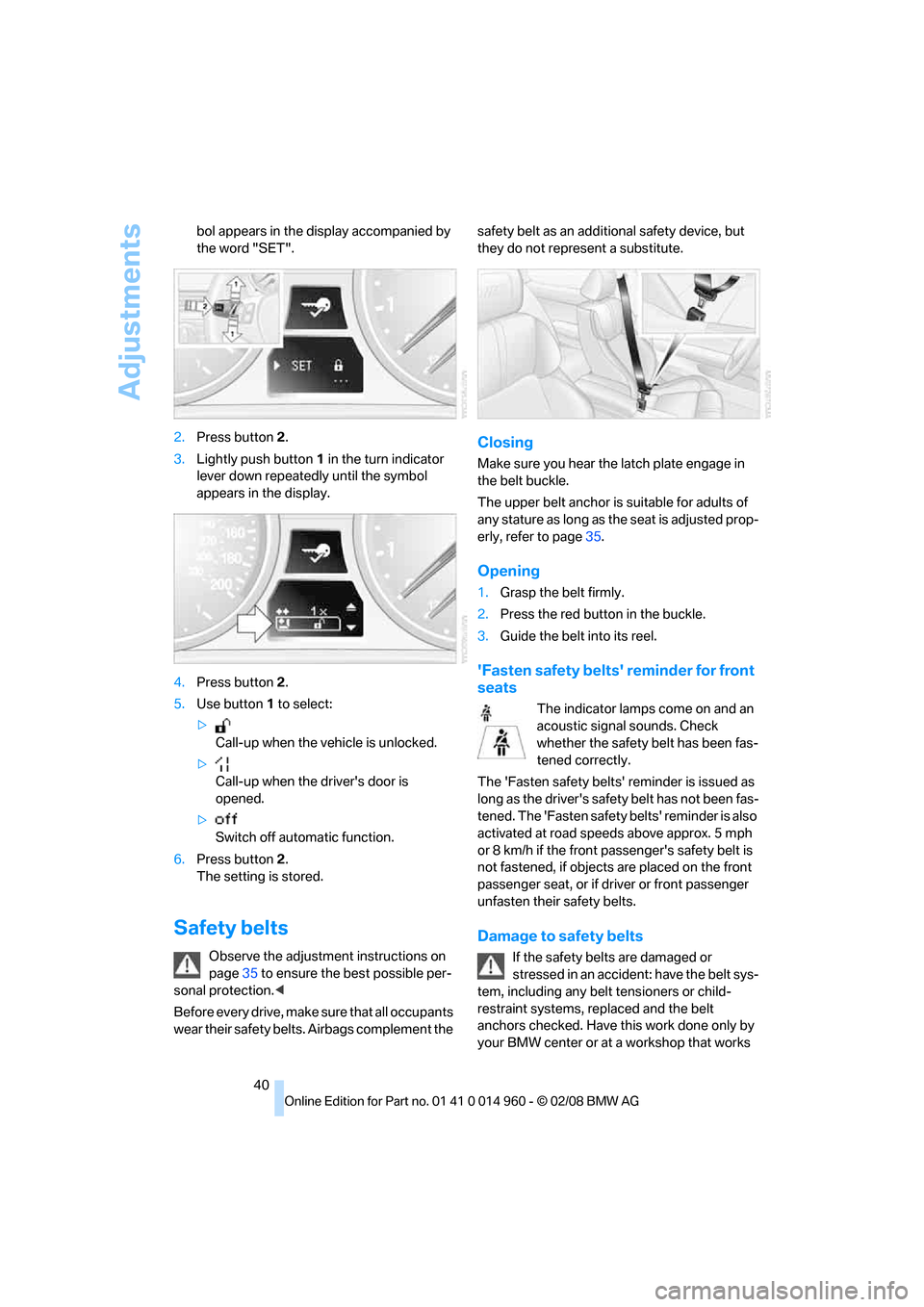
Adjustments
40 bol appears in the display accompanied by
the word "SET".
2.Press button 2.
3.Lightly push button1 in the turn indicator
lever down repeatedly until the symbol
appears in the display.
4.Press button 2.
5.Use button 1 to select:
>
Call-up when the vehicle is unlocked.
>
Call-up when the driver's door is
opened.
>
Switch off automatic function.
6.Press button 2.
The setting is stored.
Safety belts
Observe the adjustment instructions on
page35 to ensure the best possible per-
sonal protection.<
Before every drive, make sure that all occupants
wear their safety belts. Airbags complement the safety belt as an additional safety device, but
they do not represent a substitute.
Closing
Make sure you hear the latch plate engage in
the belt buckle.
The upper belt anchor is suitable for adults of
any stature as long as the seat is adjusted prop-
erly, refer to page35.
Opening
1.Grasp the belt firmly.
2.Press the red button in the buckle.
3.Guide the belt into its reel.
'Fasten safety belts' reminder for front
seats
The indicator lamps come on and an
acoustic signal sounds. Check
whether the safety belt has been fas-
tened correctly.
The 'Fasten safety belts' reminder is issued as
long as the driver's safety belt has not been fas-
tened. The 'Fasten safety belts' reminder is also
activated at road speeds above approx. 5 mph
or 8 km/h if the front passenger's safety belt is
not fastened, if objects are placed on the front
passenger seat, or if driver or front passenger
unfasten their safety belts.
Damage to safety belts
If the safety belts are damaged or
stressed in an accident: have the belt sys-
tem, including any belt tensioners or child-
restraint systems, replaced and the belt
anchors checked. Have this work done only by
your BMW center or at a workshop that works
Page 46 of 172
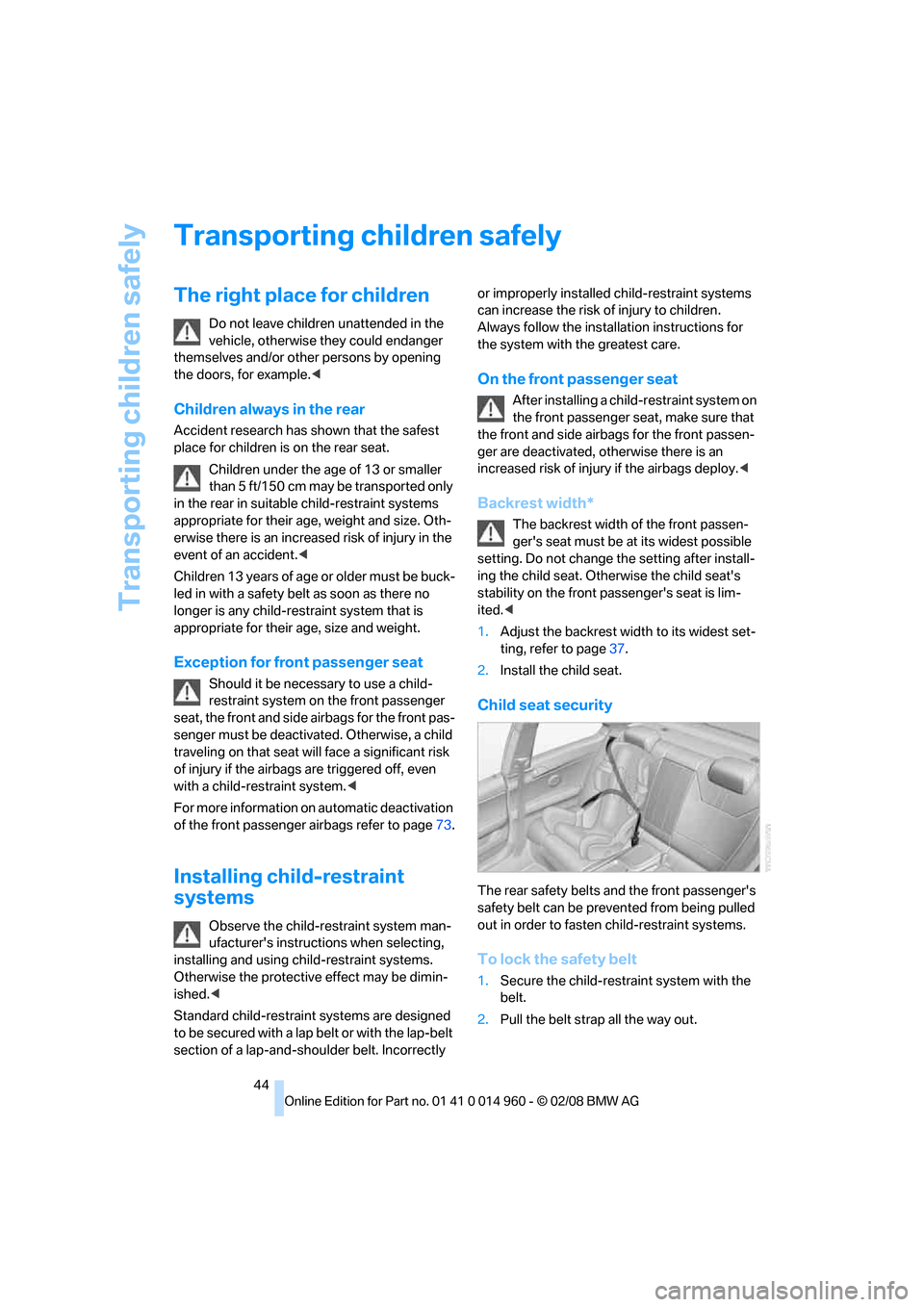
Transporting children safely
44
Transporting children safely
The right place for children
Do not leave children unattended in the
vehicle, otherwise they could endanger
themselves and/or other persons by opening
the doors, for example.<
Children always in the rear
Accident research has shown that the safest
place for children is on the rear seat.
Children under the age of 13 or smaller
than 5 ft/150 cm may be transported only
in the rear in suitable child-restraint systems
appropriate for their age, weight and size. Oth-
erwise there is an increased risk of injury in the
event of an accident.<
Children 13 years of age or older must be buck-
led in with a safety belt as soon as there no
longer is any child-restraint system that is
appropriate for their age, size and weight.
Exception for front passenger seat
Should it be necessary to use a child-
restraint system on the front passenger
seat, the front and side airbags for the front pas-
senger must be deactivated. Otherwise, a child
traveling on that seat will face a significant risk
of injury if the airbags are triggered off, even
with a child-restraint system.<
For more information on automatic deactivation
of the front passenger airbags refer to page73.
Installing child-restraint
systems
Observe the child-restraint system man-
ufacturer's instructions when selecting,
installing and using child-restraint systems.
Otherwise the protective effect may be dimin-
ished.<
Standard child-restraint systems are designed
to be secured with a lap belt or with the lap-belt
section of a lap-and-shoulder belt. Incorrectly or improperly installed child-restraint systems
can increase the risk of injury to children.
Always follow the installation instructions for
the system with the greatest care.
On the front passenger seat
After installing a child-restraint system on
the front passenger seat, make sure that
the front and side airbags for the front passen-
ger are deactivated, otherwise there is an
increased risk of injury if the airbags deploy.<
Backrest width*
The backrest width of the front passen-
ger's seat must be at its widest possible
setting. Do not change the setting after install-
ing the child seat. Otherwise the child seat's
stability on the front passenger's seat is lim-
ited.<
1.Adjust the backrest width to its widest set-
ting, refer to page37.
2.Install the child seat.
Child seat security
The rear safety belts and the front passenger's
safety belt can be prevented from being pulled
out in order to fasten child-restraint systems.
To lock the safety belt
1.Secure the child-restraint system with the
belt.
2.Pull the belt strap all the way out.
Page 47 of 172
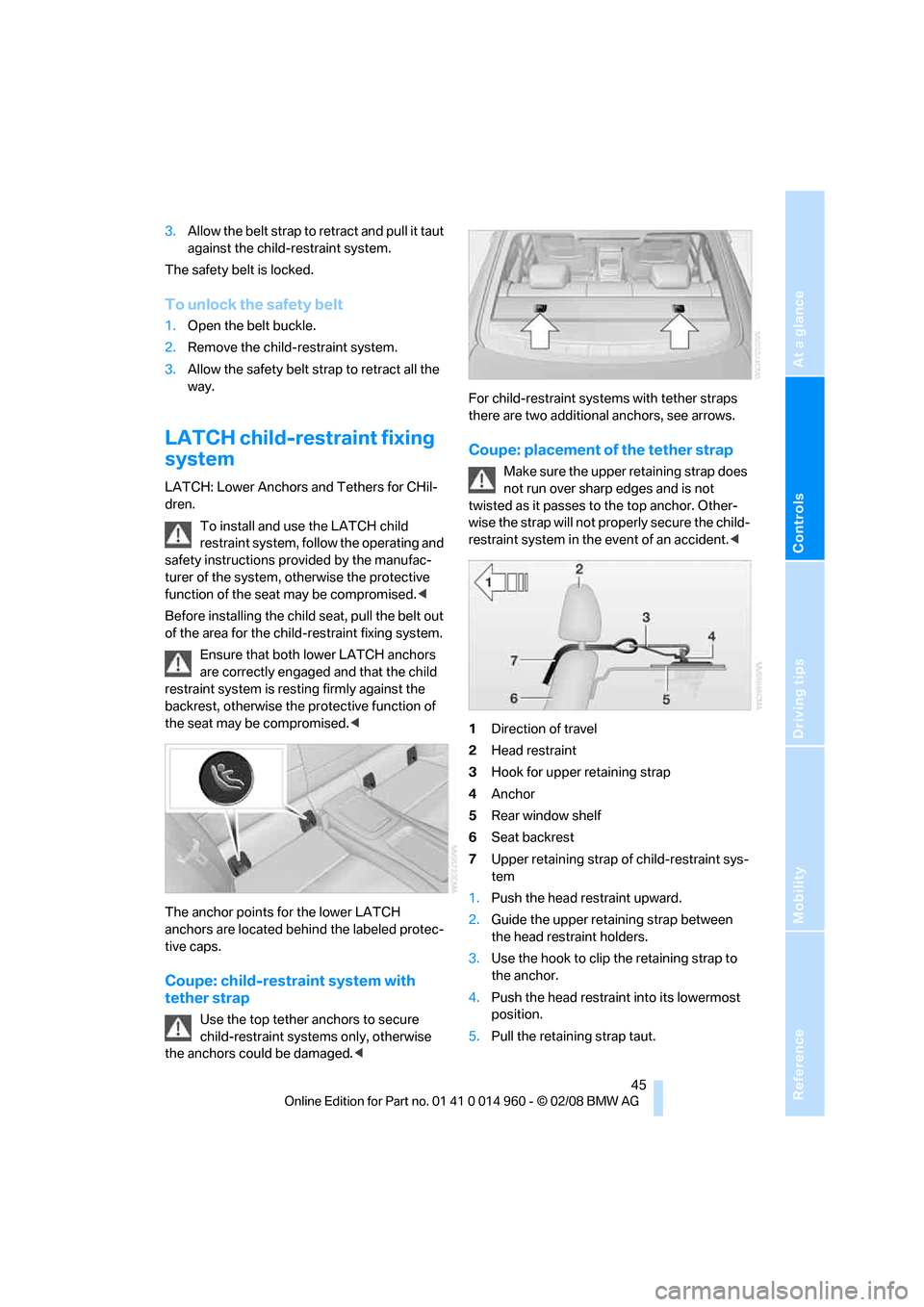
Reference
At a glance
Controls
Driving tips
Mobility
45
3.Allow the belt strap to retract and pull it taut
against the child-restraint system.
The safety belt is locked.
To unlock the safety belt
1.Open the belt buckle.
2.Remove the child-restraint system.
3.Allow the safety belt strap to retract all the
way.
LATCH child-restraint fixing
system
LATCH: Lower Anchors and Tethers for CHil-
dren.
To install and use the LATCH child
restraint system, follow the operating and
safety instructions provided by the manufac-
turer of the system, otherwise the protective
function of the seat may be compromised.<
Before installing the child seat, pull the belt out
of the area for the child-restraint fixing system.
Ensure that both lower LATCH anchors
are correctly engaged and that the child
restraint system is resting firmly against the
backrest, otherwise the protective function of
the seat may be compromised.<
The anchor points for the lower LATCH
anchors are located behind the labeled protec-
tive caps.
Coupe: child-restraint system with
tether strap
Use the top tether anchors to secure
child-restraint systems only, otherwise
the anchors could be damaged.
Coupe: placement of the tether strap
Make sure the upper retaining strap does
not run over sharp edges and is not
twisted as it passes to the top anchor. Other-
wise the strap will not properly secure the child-
restraint system in the event of an accident.<
1Direction of travel
2Head restraint
3Hook for upper retaining strap
4Anchor
5Rear window shelf
6Seat backrest
7Upper retaining strap of child-restraint sys-
tem
1.Push the head restraint upward.
2.Guide the upper retaining strap between
the head restraint holders.
3.Use the hook to clip the retaining strap to
the anchor.
4.Push the head restraint into its lowermost
position.
5.Pull the retaining strap taut.
Page 75 of 172
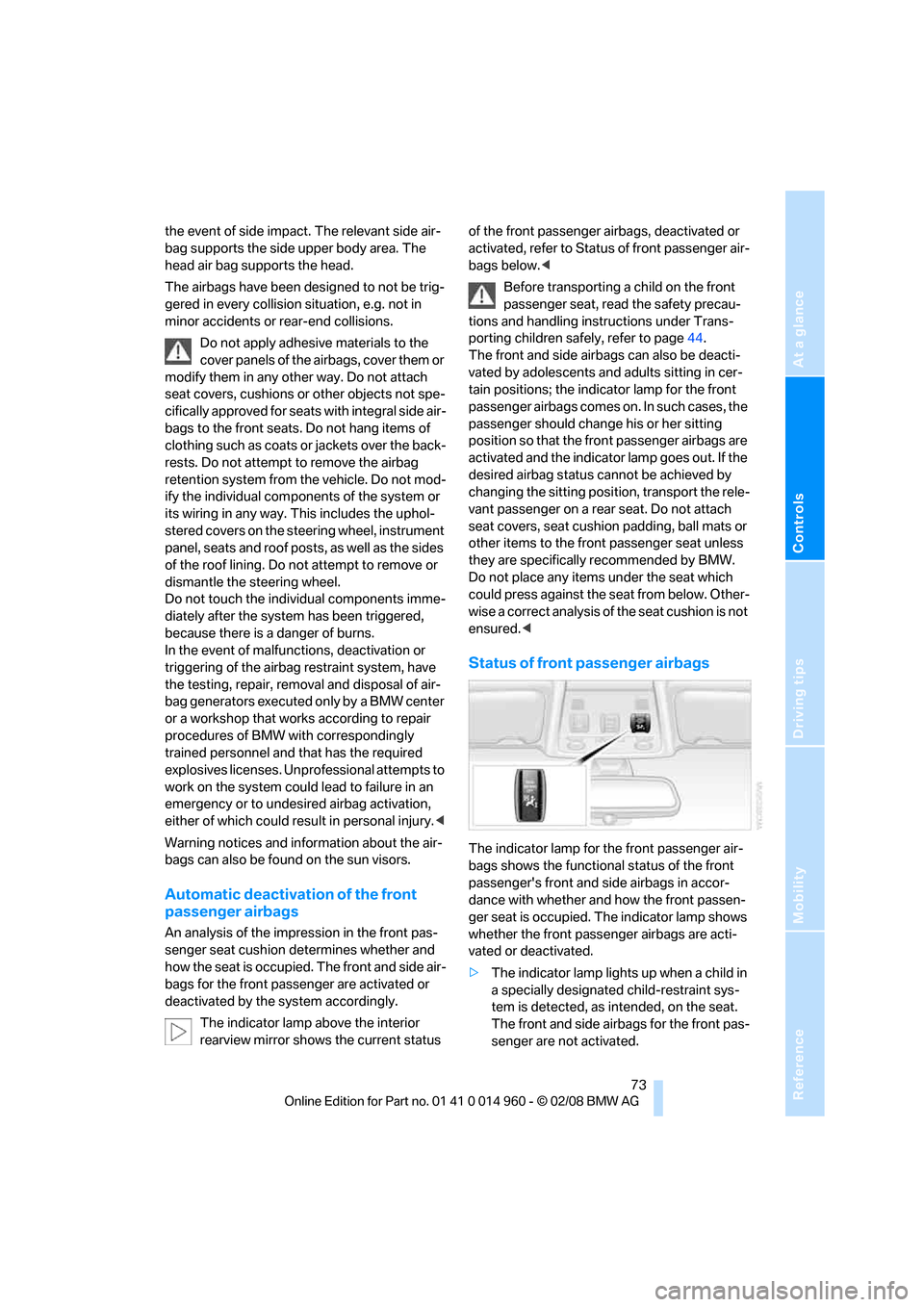
Reference
At a glance
Controls
Driving tips
Mobility
73
the event of side impact. The relevant side air-
bag supports the side upper body area. The
head air bag supports the head.
The airbags have been designed to not be trig-
gered in every collision situation, e.g. not in
minor accidents or rear-end collisions.
Do not apply adhesive materials to the
cover panels of the airbags, cover them or
modify them in any other way. Do not attach
seat covers, cushions or other objects not spe-
cifically approved for seats with integral side air-
bags to the front seats. Do not hang items of
clothing such as coats or jackets over the back-
rests. Do not attempt to remove the airbag
retention system from the vehicle. Do not mod-
ify the individual components of the system or
its wiring in any way. This includes the uphol-
stered covers on the steering wheel, instrument
panel, seats and roof posts, as well as the sides
of the roof lining. Do not attempt to remove or
dismantle the steering wheel.
Do not touch the individual components imme-
diately after the system has been triggered,
because there is a danger of burns.
In the event of malfunctions, deactivation or
triggering of the airbag restraint system, have
the testing, repair, removal and disposal of air-
bag generators executed only by a BMW center
or a workshop that works according to repair
procedures of BMW with correspondingly
trained personnel and that has the required
explosives licenses. Unprofessional attempts to
work on the system could lead to failure in an
emergency or to undesired airbag activation,
either of which could result in personal injury.<
Warning notices and information about the air-
bags can also be found on the sun visors.
Automatic deactivation of the front
passenger airbags
An analysis of the impression in the front pas-
senger seat cushion determines whether and
how the seat is occupied. The front and side air-
bags for the front passenger are activated or
deactivated by the system accordingly.
The indicator lamp above the interior
rearview mirror shows the current status of the front passenger airbags, deactivated or
activated, refer to Status of front passenger air-
bags below.<
Before transporting a child on the front
passenger seat, read the safety precau-
tions and handling instructions under Trans-
porting children safely, refer to page44.
The front and side airbags can also be deacti-
vated by adolescents and adults sitting in cer-
tain positions; the indicator lamp for the front
passenger airbags comes on. In such cases, the
passenger should change his or her sitting
position so that the front passenger airbags are
activated and the indicator lamp goes out. If the
desired airbag status cannot be achieved by
changing the sitting position, transport the rele-
vant passenger on a rear seat. Do not attach
seat covers, seat cushion padding, ball mats or
other items to the front passenger seat unless
they are specifically recommended by BMW.
Do not place any items under the seat which
could press against the seat from below. Other-
wise a correct analysis of the seat cushion is not
ensured.<
Status of front passenger airbags
The indicator lamp for the front passenger air-
bags shows the functional status of the front
passenger's front and side airbags in accor-
dance with whether and how the front passen-
ger seat is occupied. The indicator lamp shows
whether the front passenger airbags are acti-
vated or deactivated.
>The indicator lamp lights up when a child in
a specially designated child-restraint sys-
tem is detected, as intended, on the seat.
The front and side airbags for the front pas-
senger are not activated.
Page 76 of 172
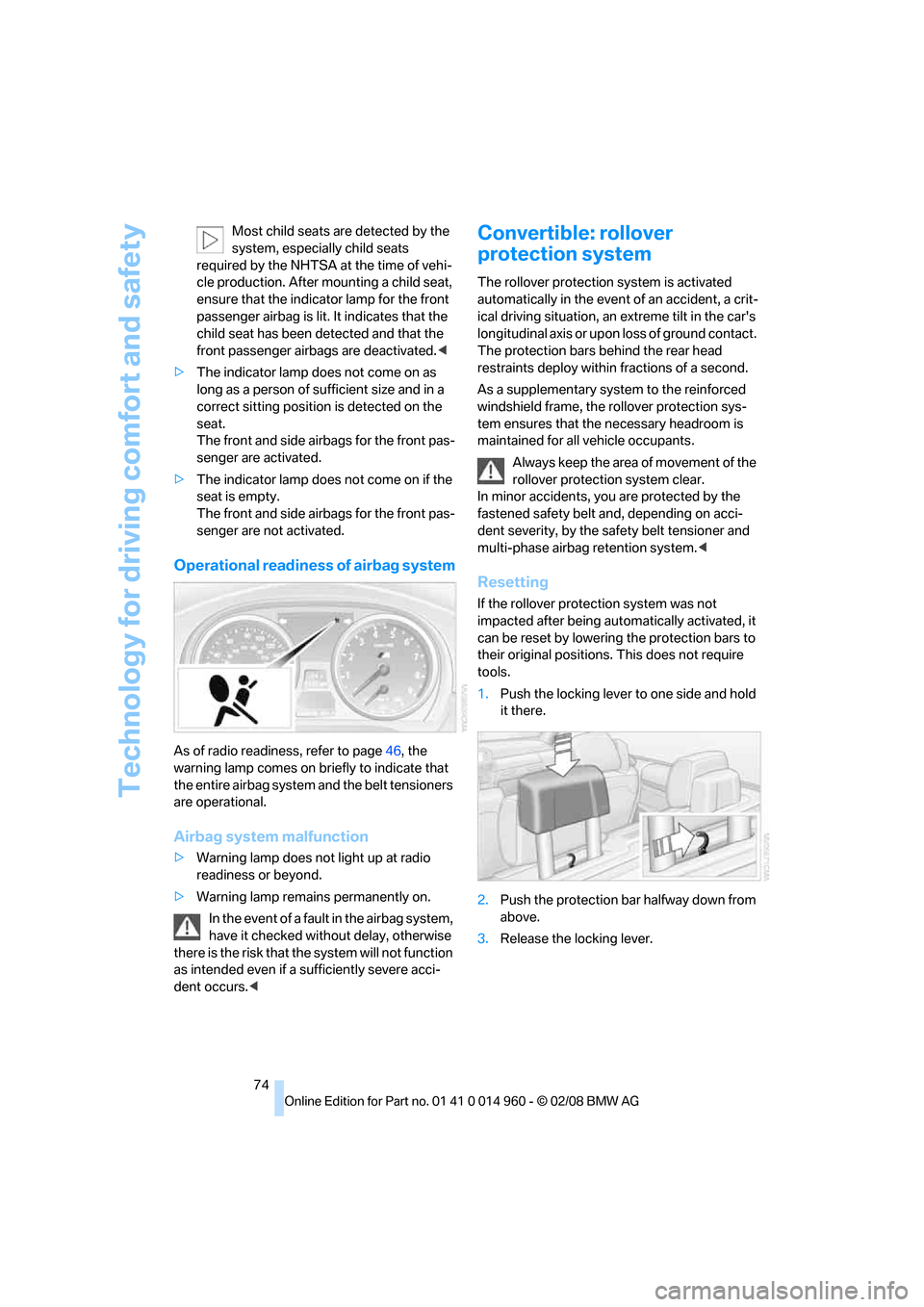
Technology for driving comfort and safety
74 Most child seats are detected by the
system, especially child seats
required by the NHTSA at the time of vehi-
cle production. After mounting a child seat,
ensure that the indicator lamp for the front
passenger airbag is lit. It indicates that the
child seat has been detected and that the
front passenger airbags are deactivated.<
>The indicator lamp does not come on as
long as a person of sufficient size and in a
correct sitting position is detected on the
seat.
The front and side airbags for the front pas-
senger are activated.
>The indicator lamp does not come on if the
seat is empty.
The front and side airbags for the front pas-
senger are not activated.
Operational readiness of airbag system
As of radio readiness, refer to page46, the
warning lamp comes on briefly to indicate that
the entire airbag system and the belt tensioners
are operational.
Airbag system malfunction
>Warning lamp does not light up at radio
readiness or beyond.
>Warning lamp remains permanently on.
In the event of a fault in the airbag system,
have it checked without delay, otherwise
there is the risk that the system will not function
as intended even if a sufficiently severe acci-
dent occurs.<
Convertible: rollover
protection system
The rollover protection system is activated
automatically in the event of an accident, a crit-
ical driving situation, an extreme tilt in the car's
longitudinal axis or upon loss of ground contact.
The protection bars behind the rear head
restraints deploy within fractions of a second.
As a supplementary system to the reinforced
windshield frame, the rollover protection sys-
tem ensures that the necessary headroom is
maintained for all vehicle occupants.
Always keep the area of movement of the
rollover protection system clear.
In minor accidents, you are protected by the
fastened safety belt and, depending on acci-
dent severity, by the safety belt tensioner and
multi-phase airbag retention system.<
Resetting
If the rollover protection system was not
impacted after being automatically activated, it
can be reset by lowering the protection bars to
their original positions. This does not require
tools.
1.Push the locking lever to one side and hold
it there.
2.Push the protection bar halfway down from
above.
3.Release the locking lever.
Page 160 of 172
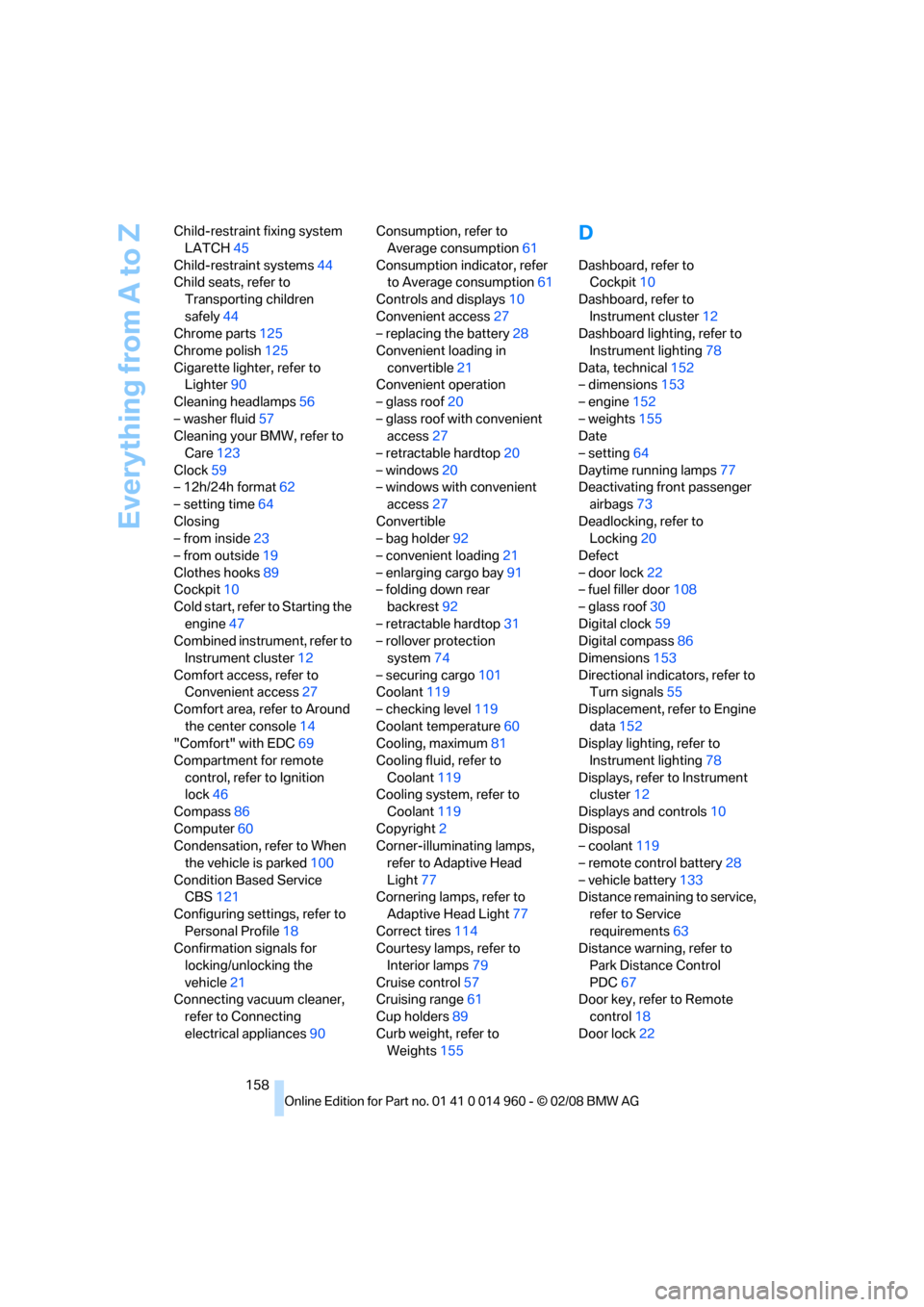
Everything from A to Z
158 Child-restraint fixing system
LATCH45
Child-restraint systems44
Child seats, refer to
Transporting children
safely44
Chrome parts125
Chrome polish125
Cigarette lighter, refer to
Lighter90
Cleaning headlamps56
– washer fluid57
Cleaning your BMW, refer to
Care123
Clock59
– 12h/24h format62
– setting time64
Closing
– from inside23
– from outside19
Clothes hooks89
Cockpit10
Cold start, refer to Starting the
engine47
Combined instrument, refer to
Instrument cluster12
Comfort access, refer to
Convenient access27
Comfort area, refer to Around
the center console14
"Comfort" with EDC69
Compartment for remote
control, refer to Ignition
lock46
Compass86
Computer60
Condensation, refer to When
the vehicle is parked100
Condition Based Service
CBS121
Configuring settings, refer to
Personal Profile18
Confirmation signals for
locking/unlocking the
vehicle21
Connecting vacuum cleaner,
refer to Connecting
electrical appliances90Consumption, refer to
Average consumption61
Consumption indicator, refer
to Average consumption61
Controls and displays10
Convenient access27
– replacing the battery28
Convenient loading in
convertible21
Convenient operation
– glass roof20
– glass roof with convenient
access27
– retractable hardtop20
– windows20
– windows with convenient
access27
Convertible
– bag holder92
– convenient loading21
– enlarging cargo bay91
– folding down rear
backrest92
– retractable hardtop31
– rollover protection
system74
– securing cargo101
Coolant119
– checking level119
Coolant temperature60
Cooling, maximum81
Cooling fluid, refer to
Coolant119
Cooling system, refer to
Coolant119
Copyright2
Corner-illuminating lamps,
refer to Adaptive Head
Light77
Cornering lamps, refer to
Adaptive Head Light77
Correct tires114
Courtesy lamps, refer to
Interior lamps79
Cruise control57
Cruising range61
Cup holders89
Curb weight, refer to
Weights155
D
Dashboard, refer to
Cockpit10
Dashboard, refer to
Instrument cluster12
Dashboard lighting, refer to
Instrument lighting78
Data, technical152
– dimensions153
– engine152
– weights155
Date
– setting64
Daytime running lamps77
Deactivating front passenger
airbags73
Deadlocking, refer to
Locking20
Defect
– door lock22
– fuel filler door108
– glass roof30
Digital clock59
Digital compass86
Dimensions153
Directional indicators, refer to
Turn signals55
Displacement, refer to Engine
data152
Display lighting, refer to
Instrument lighting78
Displays, refer to Instrument
cluster12
Displays and controls10
Disposal
– coolant119
– remote control battery28
– vehicle battery133
Distance remaining to service,
refer to Service
requirements63
Distance warning, refer to
Park Distance Control
PDC67
Door key, refer to Remote
control18
Door lock22
Page 163 of 172
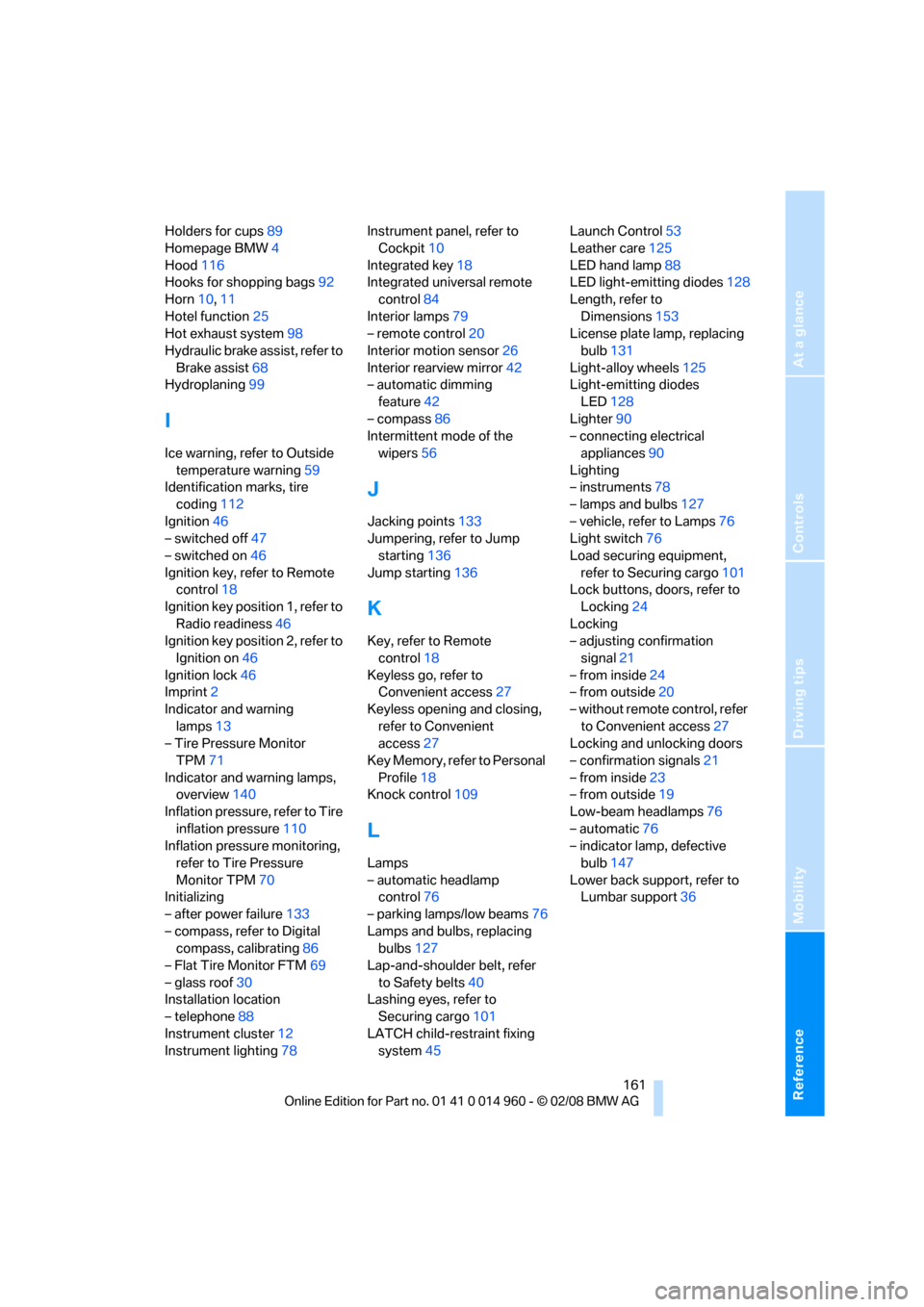
Reference
At a glance
Controls
Driving tips
Mobility
161
Holders for cups89
Homepage BMW4
Hood116
Hooks for shopping bags92
Horn10,11
Hotel function25
Hot exhaust system98
Hydraulic brake assist, refer to
Brake assist68
Hydroplaning99
I
Ice warning, refer to Outside
temperature warning59
Identification marks, tire
coding112
Ignition46
– switched off47
– switched on46
Ignition key, refer to Remote
control18
Ignition key position 1, refer to
Radio readiness46
Ignition key position 2, refer to
Ignition on46
Ignition lock46
Imprint2
Indicator and warning
lamps13
– Tire Pressure Monitor
TPM71
Indicator and warning lamps,
overview140
Inflation pressure, refer to Tire
inflation pressure110
Inflation pressure monitoring,
refer to Tire Pressure
Monitor TPM70
Initializing
– after power failure133
– compass, refer to Digital
compass, calibrating86
– Flat Tire Monitor FTM69
– glass roof30
Installation location
– telephone88
Instrument cluster12
Instrument lighting78Instrument panel, refer to
Cockpit10
Integrated key18
Integrated universal remote
control84
Interior lamps79
– remote control20
Interior motion sensor26
Interior rearview mirror42
– automatic dimming
feature42
– compass86
Intermittent mode of the
wipers56
J
Jacking points133
Jumpering, refer to Jump
starting136
Jump starting136
K
Key, refer to Remote
control18
Keyless go, refer to
Convenient access27
Keyless opening and closing,
refer to Convenient
access27
Key Memory, refer to Personal
Profile18
Knock control109
L
Lamps
– automatic headlamp
control76
– parking lamps/low beams76
Lamps and bulbs, replacing
bulbs127
Lap-and-shoulder belt, refer
to Safety belts40
Lashing eyes, refer to
Securing cargo101
LATCH child-restraint fixing
system45Launch Control53
Leather care125
LED hand lamp88
LED light-emitting diodes128
Length, refer to
Dimensions153
License plate lamp, replacing
bulb131
Light-alloy wheels125
Light-emitting diodes
LED128
Lighter90
– connecting electrical
appliances90
Lighting
– instruments78
– lamps and bulbs127
– vehicle, refer to Lamps76
Light switch76
Load securing equipment,
refer to Securing cargo101
Lock buttons, doors, refer to
Locking24
Locking
– adjusting confirmation
signal21
– from inside24
– from outside20
– without remote control, refer
to Convenient access27
Locking and unlocking doors
– confirmation signals21
– from inside23
– from outside19
Low-beam headlamps76
– automatic76
– indicator lamp, defective
bulb147
Lower back support, refer to
Lumbar support36
Page 165 of 172
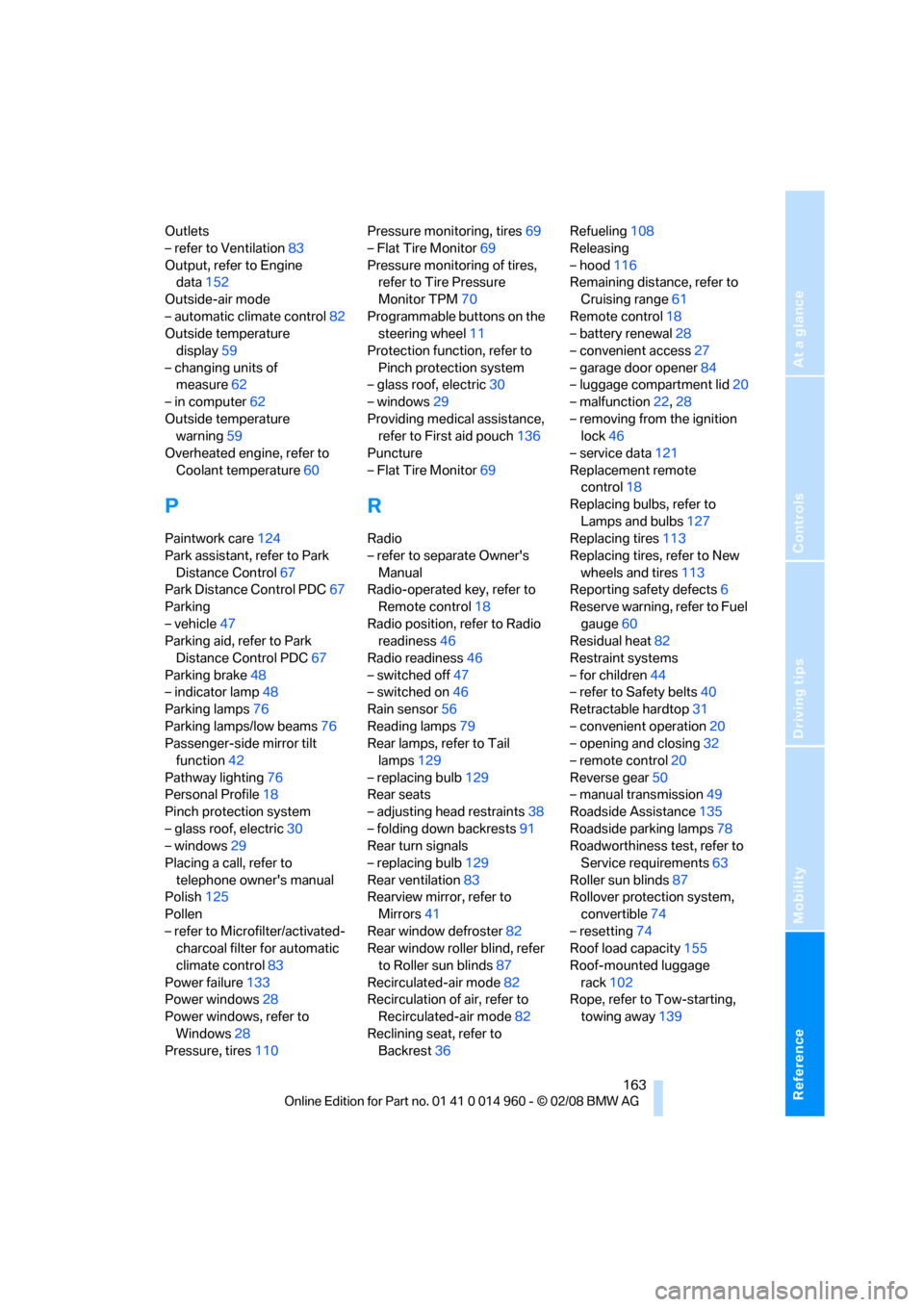
Reference
At a glance
Controls
Driving tips
Mobility
163
Outlets
– refer to Ventilation83
Output, refer to Engine
data152
Outside-air mode
– automatic climate control82
Outside temperature
display59
– changing units of
measure62
– in computer62
Outside temperature
warning59
Overheated engine, refer to
Coolant temperature60
P
Paintwork care124
Park assistant, refer to Park
Distance Control67
Park Distance Control PDC67
Parking
– vehicle47
Parking aid, refer to Park
Distance Control PDC67
Parking brake48
– indicator lamp48
Parking lamps76
Parking lamps/low beams76
Passenger-side mirror tilt
function42
Pathway lighting76
Personal Profile18
Pinch protection system
– glass roof, electric30
– windows29
Placing a call, refer to
telephone owner's manual
Polish125
Pollen
– refer to Microfilter/activated-
charcoal filter for automatic
climate control83
Power failure133
Power windows28
Power windows, refer to
Windows28
Pressure, tires110Pressure monitoring, tires69
– Flat Tire Monitor69
Pressure monitoring of tires,
refer to Tire Pressure
Monitor TPM70
Programmable buttons on the
steering wheel11
Protection function, refer to
Pinch protection system
– glass roof, electric30
– windows29
Providing medical assistance,
refer to First aid pouch136
Puncture
– Flat Tire Monitor69
R
Radio
– refer to separate Owner's
Manual
Radio-operated key, refer to
Remote control18
Radio position, refer to Radio
readiness46
Radio readiness46
– switched off47
– switched on46
Rain sensor56
Reading lamps79
Rear lamps, refer to Tail
lamps129
– replacing bulb129
Rear seats
– adjusting head restraints38
– folding down backrests91
Rear turn signals
– replacing bulb129
Rear ventilation83
Rearview mirror, refer to
Mirrors41
Rear window defroster82
Rear window roller blind, refer
to Roller sun blinds87
Recirculated-air mode82
Recirculation of air, refer to
Recirculated-air mode82
Reclining seat, refer to
Backrest36Refueling108
Releasing
– hood116
Remaining distance, refer to
Cruising range61
Remote control18
– battery renewal28
– convenient access27
– garage door opener84
– luggage compartment lid20
– malfunction22,28
– removing from the ignition
lock46
– service data121
Replacement remote
control18
Replacing bulbs, refer to
Lamps and bulbs127
Replacing tires113
Replacing tires, refer to New
wheels and tires113
Reporting safety defects6
Reserve warning, refer to Fuel
gauge60
Residual heat82
Restraint systems
– for children44
– refer to Safety belts40
Retractable hardtop31
– convenient operation
20
– opening and closing32
– remote control20
Reverse gear50
– manual transmission49
Roadside Assistance135
Roadside parking lamps78
Roadworthiness test, refer to
Service requirements63
Roller sun blinds87
Rollover protection system,
convertible74
– resetting74
Roof load capacity155
Roof-mounted luggage
rack102
Rope, refer to Tow-starting,
towing away139